BY TOM BETTS
The 30,000 or so rocky islands that define the eastern shore of Georgian Bay can be absolutely stunning in their beauty – the pinks and grays of gneiss and other ancient rocks contrasting with bluer than blue skies and water and greener than green pines sure paints a pretty picture. But these same landscapes can be rugged, unforgiving, and harsh, especially for those things trying to eek out a living there – winter and summer beat down with intense heat and bitter cold, gale force winds blow with regularity, and often there is either too much water or not enough.
And so it has always fascinated me that the rocky environments of Georgian Bay’s islands can support an amazing diversity of wildflowers, and that these plants not only establish themselves in the nooks and crannies of the broken Canadian Shield, but they often seem to thrive there. They are, indeed, diamonds in a rough environment, little gems splashing a lot of colour onto a rocky landscape. But they can easily be overlooked.
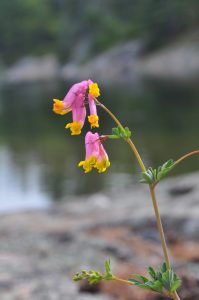
Pale Corydalis
For our family, no island stop would be complete without an exploratory wildflower hike, just to see who is in bloom at a particular time. And of course we have our favourites.
Who would come first chronologically in this parade of colour is a difficult question, but certainly the pale corydalis would be near the beginning of the list. It also has one of the longest bloom periods, adding its little touch of colour from May to September. There are not many flowers that combine pink with yellow, but this delicate member of the poppy family does it well. It’s drooping, tubular flowers — pink with a yellow tip — punctuate stalks of bluish-green, serrated foliage, and they are a delight to find where so much is hard rock and crunchy lichens.
At about the same time, the wild columbine (Aquilegia canadensis) dazzles us with a similar color combination. Often colonizing steep, rocky cliffs where not much else will grow, this early bloomer in the buttercup family displays unusual drooping flowers pairing vivid red and vibrant yellow. The contrast of the red spurs of wild columbine against a backdrop of darker rocks is not soon forgotten. Though columbines in a variety of colors are common in backyard gardens, it is tough to beat the colors of the eastern red wild columbine.
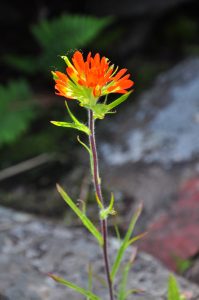
Indian Paintbrush
Toward the interior of an island, on a quiet bay where white-throated sparrows and nuthatches fill the morning air with song, we find the stunning Indian paintbrush. Though the actual flowers of this member of the snapdragon family are nondescript and hidden, the colorful scarlet-tipped bracts on a 30 cm stem paint a pretty picture along a forested shoreline.
And nearby, in the pine woods, another exciting find awaits — the pink lady’s-slipper. On a leafless stalk a large, pink, inflated slipper-like flower hangs like few other flowers do. It is unmistakable. Large and showy orchids, lady’s-slippers often multiply into a substantial grouping of plants. A scene such as this can be quite a find.
Little wonder the pink lady’s-slipper is celebrated as the provincial wildflower of Prince Edward Island, and the state wildflower of New Hampshire.
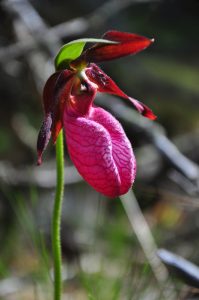
Pink Lady’s-Slipper
As spring moves into summer, the islands light up with the several centimetre-high mossy stonecrop. This succulent is an escapee of European gardens, but it is nonetheless quite beautiful as its bright yellow blooms paint themselves into what seems like every available crack or depression in the island rocks. One day there is nothing, and the next, an explosion of colour!
For those with a passion for blue, the frail harebell appears in early to mid-summer, finding a root-hold wherever conditions are just right. These are small plants with thread-like stalks, and the tiny deep blue bell-like flowers can easily be missed. Look closely in the miniature wildflower gardens of the islands, as the blooms of harebell stand a mere 15 cm off the ground.
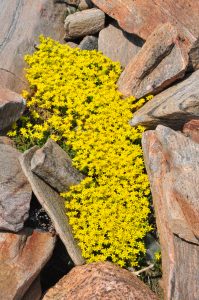
Mossy Stonecrop
And nearby one can usually find blue flag, a showy member of the iris family. Blue flags like to have their feet wet and will most often be found at the edge of little temporary pools on the islands or at the edge of the water. They are tall, sturdy plants, and the large violet-blue flowers can be enjoyed throughout much of the summer. Quebec recognizes the blue flag as its provincial flower.
One flower that had me stumped for a while was swamp candles. In a marshy area of a large island, I had noticed first some small, erect plants with strange bulbous “growths” on the stems but no sign of flowers. A year later and a month earlier, the spires were on fire with bright yellow blooms, each with two red spots at the base of each petal. Thanks to the flowers, I now recognize this impressive member of the primrose family, and against a watery background it is a picture-perfect flower.
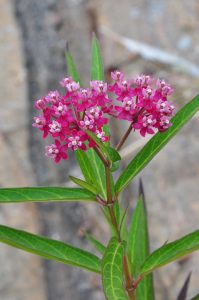
Swamp Milkweed
A larger, sturdier plant but no less beautiful is the swamp milkweed. Like others in the milkweed family, this plant attracts many insects and especially butterflies to its deep pink flowers that top the plant in umbel-like clusters. True to its name, swamp milkweed is often found in damp areas. What a sight it is to discover swamp milkweed on an outer island, its flowers smothered by a few dozen monarchs!
It has been a long wait for the August blooms of cardinal flower, and there’s probably not a cottager anywhere who looks forward to the end of the cottage season. Sadly, to us, that is what cardinal flower signifies. But as if to temper the disappointment we all feel, the scarlet red blooms on meter-high stalks at the water’s edge can certainly brighten any day. The beautiful deep red flowers are pollinated chiefly by hummingbirds, who have a selective advantage over insects in probing the tube-shaped blooms.
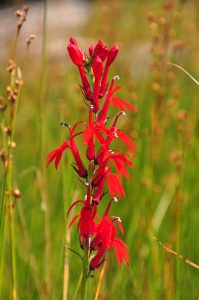
Cardinal Flower
The amazing wildflowers that brighten the Georgian Bay landscape are easily missed – after all, most are very small, and most do not typically bloom in large patches that stand out to a casual observer. And besides, there are so many other things deserving of attention – the remarkable old-as-time rocks themselves, a myriad of bird species occupying diverse habitats, stunning sunsets and soothing sunrises, and so much more. But sometimes the small steals the show, if we let it, and these diamonds in the rough need no polish.